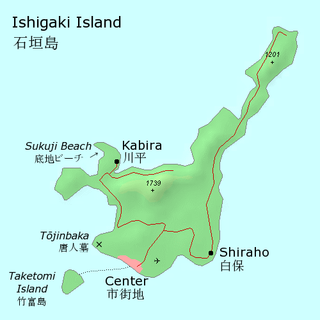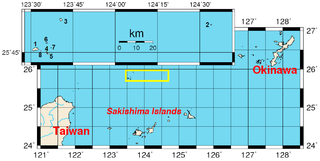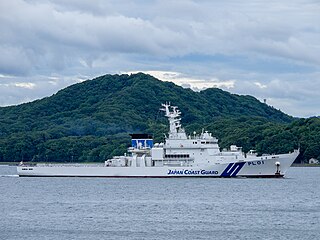
Ishigaki Island, also known as Ishigakijima, is a Japanese island south-west of Okinawa Hontō and the second-largest island of the Yaeyama Island group, behind Iriomote Island. It is located approximately 411 km (255 mi) south-west of Okinawa Hontō. It is within the City of Ishigaki in Okinawa Prefecture. The city functions as the business and transport center of the archipelago. The island is served by New Ishigaki Airport, the largest airport in the Yaeyamas.

The Senkaku Islands, also known as the Pinnacle Islands or the Diaoyu Islands in China and as the Tiaoyutai Islands in Taiwan, are a group of uninhabited islands in the East China Sea, administered by Japan.

Naoto Kan is a Japanese politician who served as Prime Minister of Japan and President of the Democratic Party of Japan (DPJ) from June 2010 to September 2011. Kan was the first Prime Minister since the resignation of Junichiro Koizumi in 2006 to serve for more than one year, with his predecessors Yukio Hatoyama, Tarō Asō, Yasuo Fukuda, and Shinzo Abe either resigning prematurely or losing an election. On 26 August 2011, Kan announced his resignation. Yoshihiko Noda was elected as his successor. On 1 August 2012, United Nations Secretary-General Ban Ki-moon announced Kan would be one of the members of the UN high-level panel on the post-2015 development agenda.

The Japan Coast Guard is the coast guard responsible for the protection of the coastline of Japan under the oversight of the Ministry of Land, Infrastructure, Transport and Tourism. It consists of about 13,700 personnel. The Japan Coast Guard was founded in 1948 as the Maritime Safety Agency and received its current English name in 2000.

MY Ady Gil was a 78-foot (24 m), wave-piercing trimaran originally created as part of a project to break the world record for circumnavigating the globe in a powerboat. Powered by biodiesel fuel, the vessel was also capable of running on regular diesel fuel. It used other eco-friendly materials such as vegetable oil lubricants, hemp composites, and non-toxic anti-fouling, and had features such as bilge-water filters.

China–Japan relations or Sino-Japanese relations are the bilateral relations between China and Japan. The countries are geographically separated by the East China Sea. Japan has been strongly influenced throughout its history by China, especially by the East and Southeast through the gradual process of Sinicization with its language, architecture, culture, cuisine, religion, philosophy, and law. When Japan was forced to open trade relations with the West after the Perry Expedition in the mid-19th century, Japan plunged itself through an active process of Westernization during the Meiji Restoration in 1868 and began viewing China under the Qing dynasty as an antiquated civilization unable to defend itself against foreign forces—in part due to the First and Second Opium Wars along with the Eight-Nation Alliance's involvement in suppressing the Boxer Rebellion. Japan eventually took advantage of such weaknesses by invading China, including the First Sino-Japanese War and the Second Sino-Japanese War.

Hateruma-class patrol vessel is a class of PL type patrol vessels of the Japan Coast Guard. PL stands for "Patrol vessel Large", and the class name "Hateruma" is named after Hateruma-jima, the southernmost inhabited island of Japan.

The Senkaku Islands dispute, or Diaoyu Islands dispute, is a territorial dispute over a group of uninhabited islands known as the Senkaku Islands in Japan, the Diaoyu Islands in China, and Tiaoyutai Islands in Taiwan. Aside from a 1945 to 1972 period of administration by the United States as part of the Ryukyu Islands, the archipelago has been controlled by Japan since 1895. The territory is close to key shipping lanes and rich fishing grounds, and there may be oil reserves in the area.
Senkaku Jinja (尖閣神社) is a Shinto shrine located on Uotsuri-jima in the Senkaku Islands, Japan. The shrine is dedicated to Amaterasu.

Hinomoto Oniko is a Japanese moe character created in 2010 which originated from the Breaking News (VIP) Board on 2channel, and has since become an internet meme within various forums and imageboards in Japan. The character is a moe anthropomorphism of the phrase "日本鬼子", a commonly used Chinese ethnic slur against people of Japanese descent.
The 2010 Eocheong boat collision incident occurred on December 18, 2010 off Eocheong Island in the Yellow Sea. It involved the Republic of Korea Coast Guard (ROK) and fishermen from the People's Republic of China. About 503 Chinese trawlers were illegally fishing about 12,000 kilometers off the island of Eocheong. A Republic of Korea Coast Guard ship shot the fishermen with water cannons to move them back. When the coast guardsmen began boarding the ship to detain the fishermen, the trawler intentionally collided with one of the Korean coastguard patrol boats.

Ganbare Nippon! Zenkoku Kōdō Iinkai (頑張れ日本!全国行動委員会), usually abbreviated to Ganbare Nippon (頑張れ日本), is a Japanese conservative nationalist group founded on February 2, 2010. One of the founders was right-wing filmmaker and playwright Satoru Mizushima.

From August to September 2012, a series of anti-Japanese demonstrations were held across more than 100 cities in China. The main cause of the demonstrations was the escalation of the Senkaku/Diaoyu/Tiaoyutai Islands dispute between China and Japan around the time of the anniversary of the Mukden Incident of 1931, which was the de facto catalyst to the Japanese invasion of Manchuria, culminating in a humiliating Chinese defeat and a decisive Japanese victory vis-à-vis total consolidation and annexation of Manchuria. Protesters in several cities later became violent and local authorities began arresting demonstrators and banning the demonstrations.

Baodiao movement is a social movement originating among Republic of China students in the United States in the 1970s, and more recently expressed in China that asserts Chinese sovereignty over the Senkaku/Diaoyu/Tiaoyutai Islands. The territorial right to the islands is disputed among the China, the Taiwan, and Japan. Action Committee for Defending the Diaoyu Islands and China Federation for Defending the Diaoyu Islands are the main representative organizations in the movement.

China Marine Surveillance was a maritime surveillance agency of China.

The Shikishima-class patrol vessel is a class of PLH type patrol vessels of the Japan Coast Guard. In the official classification, Shikishima and Akitsushima are treated as the only ships in their classes, respectively; and Reimei is treated as the lead ship of her class. The Shikishima class was once the world's largest coast guard vessel until it was surpassed by the Chinese Zhaotou-class patrol cutter in 2015.

The Kunigami-class patrol vessel is a class of 1,000 ton-class PL type patrol vessels of the Japan Coast Guard (JCG).





















